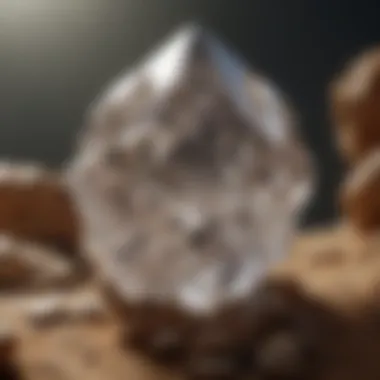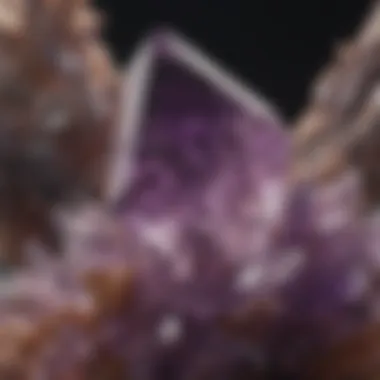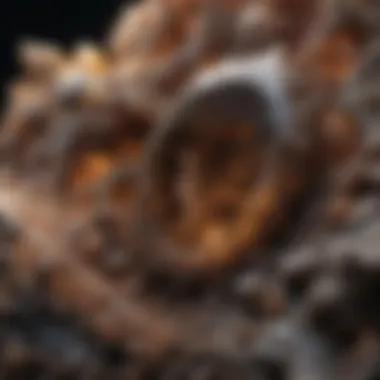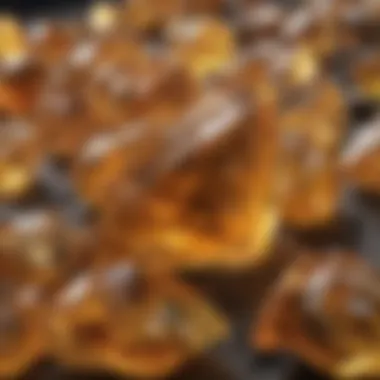Unveiling the Diverse World of Quartz: An In-Depth Exploration


Rock and Fossil Identification
India, known for its rich geological heritage, boasts a diverse range of quartz varieties that enthrall rock and fossil enthusiasts. From the famed Amethyst to the intriguing Agate, each type bears distinctive characteristics waiting to be uncovered. When identifying quartz specimens, collectors should observe features such as color, transparency, and crystal structure. Utilizing tools like magnifying loupes and hardness testing kits enhances the accuracy of identification, aiding enthusiasts in distinguishing between the myriad quartz types available.
Collecting Tips and Techniques
Delving into the world of quartz collection requires finesse and knowledge. To maximize the collection experience, enthusiasts should adhere to best practices such as seeking permission before collecting in specific areas, respecting geological sites, and practicing ethical collection methods. Locating prime sites rich in quartz deposits entails research, networking with local geologists, and exploring regions known for their geological significance. Safely extracting specimens involves the use of proper tools like chisels, hammers, and safety goggles, ensuring both the collector's safety and the preservation of the specimens.
Preservation and Display
Preserving quartz specimens is essential to maintain their aesthetic and scientific value. Enthusiasts can employ various techniques such as cleaning with mild soapy water and a soft brush to remove dirt and debris without harming the specimen. Proper storage methods, including using archival-quality containers and silica gel packs to control moisture levels, help prevent degradation over time. For creative display ideas, arranging quartz specimens in themed showcases, utilizing natural lighting to accentuate their colors and formations, and incorporating geological information plaques offer a visually engaging and informative display for enthusiasts and visitors alike.
Geological Insights
Quartz's geological importance spans centuries, with its presence in diverse formations shedding light on Earth's history and geology. Understanding the geological processes that lead to quartz formation, such as hydrothermal activity or metamorphism, deepens appreciation for these exquisite specimens. From their historical significance in ancient civilizations to modern-day technological applications, quartz holds a pivotal role in human history and scientific advancements. Notable discoveries in the field continue to expand our knowledge of quartz's properties, further enriching the fascination and research within the realm of rock and fossil collection.
Introduction to Quartz
Quartz, a mineral recognized for its multifaceted properties and mesmerizing allure, serves as the focal point of this comprehensive guide. In this article, we will dissect the intricacies of quartz, unveiling its composition, formation, properties, and unique characteristics. By navigating through the variegated world of quartz, readers will gain profound insights into its significance in geology and its diverse applications in various industries
Understanding Quartz Composition
Diving into Silicon Dioxide
Embarking on an exploration of quartz composition inevitably leads us to the profound domain of silicon dioxide. This element constitutes the very essence of quartz, defining its fundamental structure and physical properties. Delving deep into the realms of silicon dioxide enlightens us on the backbone of quartz's robustness and crystal clarity. Its prevalence in quartz highlights the mineral's durability and resilience, making it a sought-after choice for scientific research and industrial applications.
The Role of Trace Elements
Within the intricate tapestry of quartz composition, trace elements play a pivotal role in shaping its unique characteristics. These elements, though present in minute quantities, wield a significant influence on the coloration and optical properties of quartz. Exploring the presence of trace elements in quartz uncovers the diverse spectrum of hues and patterns seen in different varieties of this mineral. Understanding the role of trace elements adds a layer of complexity and beauty to our appreciation of quartz's exceptional nature.
Crystal Structure of Quartz
At the core of quartz's identity lies its crystal structure, a geometric arrangement that contributes to its clarity and radiance. The orderly arrangement of silicon and oxygen atoms forms a lattice that defines the distinctiveness of quartz crystals. This crystalline structure not only bestows quartz with its unique optical properties but also ensures its remarkable stability and hardness. Unraveling the crystal structure of quartz sheds light on the mineral's innate elegance and structural integrity
Formation and Occurrence
Geological Processes
The genesis of quartz involves intricate geological processes that shape its formation and distribution across diverse terrains. From hydrothermal activities to metamorphic transformations, the geological journey of quartz elucidates its enduring presence in the Earth's crust. Exploring the geological processes underlying quartz formation unravels the intricate tapestry of natural phenomena that converge to create this remarkable mineral.


Primary Deposits of Quartz
The primary deposits of quartz serve as reservoirs that bear witness to the mineral's origins and evolution through millennia. These concentrated deposits, often found in igneous and sedimentary rocks, showcase the diversity and abundance of quartz manifestations in nature. Studying the primary deposits of quartz unveils the geological events and forces that have sculpted these mineral-rich enclaves, offering a glimpse into the Earth's ancient history
Global Distribution
Across the globe, quartz manifests in a myriad of environments, contributing to its widespread distribution and accessibility. From arid deserts to lush rainforests, quartz thrives in varied climatic conditions, reflecting the adaptability and resilience of this mineral. Reflecting on the global distribution of quartz presents a panoramic view of its ubiquity and significance in geological settings, enriching our understanding of the mineral's presence on a worldwide scale
Properties of Quartz
Hardness and Durability
The inherent hardness and durability of quartz render it a versatile mineral with a multitude of applications across industries. Its remarkable resistance to abrasion and scratching positions quartz as a favored material for jewelry, construction, and scientific endeavors. Exploring the hardness and durability of quartz unravels its enduring nature and enduring beauty, making it a timeless choice for diverse creative pursuits
Color Variations in Quartz
Quartz's color spectrum spans a kaleidoscope of hues, from pristine whites to vibrant reds and deep purples, reflecting the diverse mineral compositions within its structure. The myriad color variations in quartz enchant collectors and enthusiasts, offering a treasure trove of aesthetic possibilities and creative inspirations. Delving into the hues and tones of quartz unveils a world of artistic expression and geological fascination, inviting us to explore the rich palette of nature
Optical Characteristics
The optical allure of quartz lies in its transparent and translucent qualities that capture and refract light with mesmerizing brilliance. Its optical characteristics, including birefringence and pleochroism, imbue quartz with a dynamic visual appeal that varies with each angle and light source. Unraveling the optical properties of quartz unveils its prismatic identity and spectral radiance, enhancing its allure as a gemstone and scientific marvel
Popular Types of Quartz
Within the intricate world of quartz, exploring the popular types is paramount to understanding its allure and significance as highly sought-after specimens in various industries and collections. Each type of quartz boasts unique characteristics, making them not only visually appealing but also scientifically and historically intriguing. From the ethereal beauty of Amethyst to the gentle elegance of Rose Quartz and the vibrant energy of Citrine, these popular varieties offer a diverse palette of colors and properties that cater to different tastes and purposes.
Amethyst
Royal Purple Beauty
Delve into the captivating allure of the royal purple beauty that is Amethyst, a gem cherished for its regal hue and mesmerizing appeal. This specific aspect of Amethyst evokes a sense of luxury and sophistication, making it a coveted choice among gem enthusiasts and collectors alike. The key characteristic of the royal purple coloration lies in its rarity and rich tone, symbolizing power and elegance. The unique feature of Amethyst's royal purple beauty lies in its calming presence and ability to enhance spiritual awareness, rendering it a valuable addition to this comprehensive guide.
Metaphysical Properties
Exploring the metaphysical properties of Amethyst adds another layer of intrigue to this exceptional gemstone. Its metaphysical prowess is renowned for promoting inner peace, healing, and spiritual growth. The key characteristic of these properties is their ability to cleanse negative energies and enhance intuition, making Amethyst a popular choice for meditation and energy work. The unique feature of Amethyst's metaphysical properties lies in its capacity to soothe the mind and elevate one's spiritual journey, further emphasizing its significance within this article.
Sources of Amethyst
Understanding the sources of Amethyst sheds light on its geological origins and natural formations. These sources play a crucial role in the availability and quality of this gemstone. The key characteristic of Amethyst's sources lies in their diverse locations, ranging from volcanic regions to sedimentary deposits. The unique feature of these sources is their contribution to the variety of hues and clarity levels found in Amethyst specimens, offering collectors a range of choices to explore and appreciate within the context of this article.
Rose Quartz


Soft Pink Elegance
Embrace the gentle allure of soft pink elegance embodied by Rose Quartz, a crystal renowned for its soothing properties and sentimental value. This specific aspect of Rose Quartz exudes a delicate charm and emotional depth, making it a cherished choice for both jewelry and healing practices. The key characteristic of soft pink elegance lies in its association with love, compassion, and inner peace, evoking sentiments of tenderness and nurturing. The unique feature of Rose Quartz's soft pink elegance is its ability to harmonize relationships and promote self-love, enriching the discourse of this article.
Healing and Emotional Benefits
Exploring the healing and emotional benefits of Rose Quartz unveils its profound impact on emotional well-being and self-care rituals. Its gentle energy is known for alleviating emotional wounds and enhancing empathy and compassion. The key characteristic of these benefits is their nurturing qualities, fostering feelings of comfort and emotional healing. The unique feature of Rose Quartz's healing and emotional benefits lies in its capacity to open the heart chakra and stimulate feelings of love and acceptance, making it a treasured inclusion in this comprehensive guide.
Rose Quartz Deposits
Delving into the deposits of Rose Quartz provides insights into its geological formations and characteristics. These deposits contribute significantly to the availability and quality of this beloved crystal. The key characteristic of Rose Quartz deposits is their occurrence in pegmatites and hydrothermal veins, where the crystals develop under specific geological conditions. The unique feature of these deposits is their influence on the color intensity and translucency of Rose Quartz specimens, offering collectors a nuanced perspective on this enchanting crystal within the scope of this article.
Citrine
Golden Sunshine Hue
Bask in the radiant glow of the golden sunshine hue that defines Citrine, a crystal renowned for its association with wealth, success, and positivity. This specific aspect of Citrine emanates a sense of joy and abundance, capturing the essence of sunlight in its warm tones. The key characteristic of the golden hue lies in its vibrant energy and uplifting properties, symbolizing growth and prosperity. The unique feature of Citrine's golden sunshine hue is its ability to dispel negative energies and invite wealth and success, making it a valuable addition to the discussion within this article.
Commercial and Mystical Uses
Exploring the commercial and mystical uses of Citrine reveals its multipurpose nature and versatile applications in various industries and spiritual practices. Its significance ranges from being a popular gem in jewelry design to a staple in Feng Shui practices for attracting abundance and positivity. The key characteristic of these uses is their symbiotic relationship between material wealth and spiritual alignment, offering individuals a well-rounded approach to incorporating Citrine into their lives. The unique feature of Citrine's commercial and mystical uses lies in its ability to balance material desires with spiritual growth, enhancing the collective narrative presented in this guide.
Origins of Citrine
Understanding the origins of Citrine delves into its geological formations and color variations, shedding light on the unique processes that give rise to this vibrant crystal. These origins play a crucial role in determining the quality and authenticity of Citrine specimens in the market. The key characteristic of the origins of Citrine lies in its association with amethyst and heat-treated varieties, showcasing the transformation of quartz under specific conditions. The unique feature of Citrine's origins is its ability to capture the essence of positivity and abundance, grounding its presence as a valuable inclusion in this comprehensive exploration.
Rare and Exotic Quartz Varieties
In this section of the comprehensive guide on quartz, we delve into the significance of rare and exotic quartz varieties. These unique specimens hold a special place in the world of quartz due to their scarcity and exceptional characteristics. Rock and fossil enthusiasts value these rare types for their beauty, distinct properties, and the intriguing geological processes that led to their formation. By exploring these uncommon quartz varieties, readers gain a deeper appreciation for the diversity and complexity of the mineral world.
Ametrine
Blending Amethyst and Citrine
Delving into the enchanting realm of ametrine, a naturally occurring quartz blend of amethyst and citrine, unveils a mesmerizing fusion of purple and golden hues. The unique juxtaposition of these two distinct gemstones creates a captivating color palette that is highly sought after by collectors and jewelry connoisseurs. In this article, we emphasize the exceptional beauty and rarity of ametrine, elucidating why it stands out as a top choice for those exploring quartz's exotic varieties.
Unique Color Combination
The exceptional characteristic of ametrine lies in its one-of-a-kind color combination, blending the regal purple of amethyst with the vibrant yellow of citrine seamlessly in a single gemstone. This natural occurrence of two strikingly different colors within one crystal reflects the intriguing geological processes that took place during its formation. The unique color play of ametrine adds to its allure and makes it a prized possession among collectors and enthusiasts worldwide.
Discovery and Locations


Ametrine's discovery and occurrence in nature are limited to select locations around the globe, with notable deposits found in specific regions. Understanding the geological settings where ametrine is found enhances the appreciation for this rare quartz variety. Exploring the unique characteristics, discovery history, and geological contexts of ametrine enriches the reader's knowledge of this exquisite gemstone and its significance within the realm of rare and exotic quartz varieties.
Quartz for Collectors and Enthusiasts
Quartz for Collectors and Enthusiasts holds paramount significance in this comprehensive guide to the mesmerizing world of quartz. For rock and fossil enthusiasts seeking to delve deeper into the realm of minerals, understanding quartz becomes a fundamental aspect. Collectors are drawn to the diverse varieties and unique characteristics of quartz, making it a prized addition to any collection. Enthusiasts find joy in exploring the visual allure and geological significance of quartz specimens, unraveling the mysteries embedded within each formation. By immersing oneself in the nuances of quartz, collectors and enthusiasts can enhance their appreciation for the earth's natural treasures.
Tips for Identifying Quartz
Visual Clues
In the realm of identifying quartz, visual clues play a pivotal role in distinguishing this mineral from others. The distinctive crystal habit of quartz, characterized by six-sided prisms and pyramid-shaped terminations, serves as a key visual cue for collectors and enthusiasts. The transparent to translucent nature of quartz, coupled with its brilliant glass-like luster, sets it apart from similar minerals. Understanding these unique visual characteristics enables individuals to discern quartz specimens with precision, adding to the excitement of mineral exploration.
Physical Tests
When it comes to identification, physical tests offer valuable insights into the properties of quartz. Conducting hardness tests using tools such as a steel nail or glass plate helps determine quartz's resistance to scratching, with a Mohs hardness of 7 indicating its durability. Additionally, testing for specific gravity unveils vital information about the density of quartz, aiding in differentiating it from other minerals. By employing these physical tests, collectors and enthusiasts can confirm the authenticity of quartz specimens in their collections with confidence.
Common Misidentifications
Despite its distinct characteristics, quartz is often subjected to misidentifications due to similarities with other minerals. One common misconception involves mislabeling clear quartz as diamond quartz, highlighting the need for meticulous observation. Furthermore, smoky quartz may be mistaken for other brown minerals, emphasizing the importance of thorough examination. By familiarizing oneself with these common pitfalls, collectors and enthusiasts can refine their identification skills and mitigate potential misunderstandings.
Preservation and Display
Best Practices
Preserving quartz specimens requires adherence to best practices that ensure their longevity and aesthetic appeal. Shielding specimens from direct sunlight prevents color fading and maintains their vibrancy over time. Storing quartz in a dry environment with stable temperatures safeguards against moisture-induced damage, preserving their clarity and integrity. Moreover, regular cleaning using soft brushes or compressed air removes dust and debris, unveiling the brilliance of quartz crystals to captivated onlookers.
Display Options
When showcasing quartz specimens, an array of display options allows collectors and enthusiasts to exhibit their treasures creatively. Utilizing glass display cases with adjustable shelves accents the elegance of quartz formations, providing a visually engaging presentation. Incorporating LED lighting enhances the natural beauty of quartz crystals, illuminating their intricate details and captivating colors. By selecting suitable display options, individuals can showcase their quartz collection in a compelling and aesthetically pleasing manner.
Preventing Damage
Preventing damage to quartz specimens involves conscientious care and thoughtful handling practices. Avoiding exposure to harsh chemicals or abrasive cleaners preserves the delicacy of quartz surfaces, preventing scratches or etching. Implementing protective measures such as cushioned storage boxes or individual casings shields specimens from accidental impacts or abrasions. By taking proactive steps to prevent damage, collectors and enthusiasts can safeguard the beauty and value of their cherished quartz pieces.
Global Quartz Localities
Renowned Quartz Sites
Exploring renowned quartz sites offers enthusiasts a glimpse into the geological wonders found across the globe. Locations such as the Ouachita Mountains in Arkansas and the Swiss Alps in Europe boast bountiful quartz deposits, showcasing a spectrum of colors and formations. The Smoky Quartz of the Rockies and the Citrine of Brazil stand as testament to the diverse mineral richness present in these renowned quartz sites. By embarking on expeditions to these acclaimed locales, collectors and enthusiasts can witness firsthand the splendor of quartz diversity.
Limited-Access Locations
In contrast, limited-access quartz locations present a tantalizing challenge for dedicated collectors and enthusiasts. Remote areas like the Herkimer Diamond Mines in New York and the Opal Creek Wilderness in Oregon offer exclusive access to unparalleled quartz specimens, requiring perseverance and dedication to reach. These hidden gemstone reserves hold treasures waiting to be uncovered, appealing to adventurers seeking rare and extraordinary quartz discoveries. By embracing the thrill of exploration, individuals can unearth hidden quartz wonders in these restricted but rewarding locations.
Quartz Treasures Around the World
Across the globe, an array of quartz treasures awaits discovery by passionate collectors and enthusiasts. From the vibrant Ametrine formations of Bolivia to the intricate Phantom Quartz formations of Madagascar, each locale offers a unique glimpse into the mesmerizing world of quartz. The sparkling Citrine clusters of Zambia and the celestial Rutilated Quartz of Brazil entice seekers of rare and exotic specimens with their enchanting beauty. By immersing oneself in the diverse quartz treasures scattered worldwide, collectors and enthusiasts can embark on a journey of exploration and appreciation, expanding their mineral horizons with each spectacular find.







